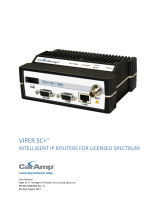
4
14.3 Module parameters 45
14.3.1 Module Off 45
14.3.2 Module Inactive 45
14.3.3 Module input 45
14.3.4 Module output 45
14.3.5 Module RWH_CMD 45
15 EtherNet/IP module description 46
15.1 Module "OFF" 46
15.2 Module "Inactive" 47
15.3 Module "Input_002" 49
15.4 Module "Output_002" 51
15.5 Module “RWH_CMD”, general description 53
15.5.1 Command activation with bit TR in PLC process data output image 56
15.5.2 Data hold time calculation for asynchronous commands 56
15.6 Module “RWH_CMD”, Read EPC data of the ID tag asynchronously 57
15.7 Module “RWH_CMD”, Read memory bank of the selected ID tag synchronously 59
15.8 Module “RWH_CMD”, Read memory bank of the ID tag asynchronously 62
15.9 Module “RWH_CMD”, Write memory bank of the selected ID tag synchronously 65
15.10 Module “RWH_CMD”, Diagnostics read 67
15.11 Module “RWH_CMD”, Execute command synchronously 70
15.11.1 Overview GET / SET commands 71
15.11.2 Command “GET DIAGNOSIS” 73
15.11.3 Command “GET MAC ADDRESS” 74
15.11.4 Command “GET UHF POWER LEVEL” 75
15.11.5 Command “GET BARGRAPH STATE” 76
15.11.6 Command “GET EPC DATA” 77
15.11.7 Command "GET ID TAG WITH HIGHEST RSSI" 78
15.11.8 Command "GET REVERSE / FORWARD POWER" 79
15.11.9 Command “SET EPC DATA” 81
15.11.10 Command “SET ID TAG PRESENCE TIME“ 82
15.11.11 Command “SET ID TAG RSSI levels “ 84
15.11.12 Command “SET ID TAG WRITE ACCESS PASSWORD“ 85
15.11.13 Command “SET ID TAG LOCK STATE“ 86
15.11.14 Command “SET READ-/WRITE HEAD ACCESS PASSWORD“ 88
15.11.15 Command “SET BARGRAPH STATE” 89
15.11.16 Command “SET DEVICE RESET” 90
15.11.17 Command “SET DATA HOLD TIME“ 91
15.11.18 Command "READ UHF MEMORY BANK SELECTIVE" 92
15.11.19 Command “WRITE UHF MEMORY BANK SELECTIVE“ 93
16 Data frame examples 95
16.1 Module “RWH_CMD”, Read EPC, RSSI and phase asynchronously 95
16.1.1 Payload traffic view 95
16.1.2 Payload traffic view, read diagnostics 95
16.2 Module “RWH_CMD”, Read memory bank of the ID tag synchronously 96
16.2.1 Payload traffic view 96
16.2.2 Payload traffic view, read diagnostics 96
16.3 Module “RWH_CMD”, Write memory bank of the ID tag synchronously 97
16.3.1 Payload traffic view 97
16.3.2 Payload traffic view, read diagnostics 97
16.4 Module “RWH_CMD”, Execute command synchronously 98





















